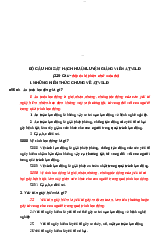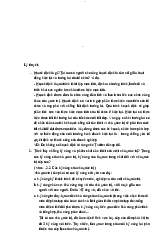



















Preview text:
lOMoARcPSD|45316467 lOMoARcPSD|45316467 LEADERSHIP Chapter 1 1.
Leadership is the influencing process between leaders and followers to
achieve organizational objectives through change (True/False) 2.
If a person is not interested and not willing to be in charge, he or she
may still be well-suited as a follower. (True/False) 3.
Taking advantage of followers for personal gain is a part of leadership. (True/False) 4.
Research indicates that leadership success is associated with being a
hard-nosed, tough manager. (true/false) 5.
Leaders tend to be born with some leadership ability and develop that
ability over time. (true/false) trait theory is based on assumption that leadership are born not made 6.
The interpersonal leadership roles include figurehead, leader, and monitor. liaison (true/false) 7.
Spokesperson is a decisional role. is a informational role (true/false) 8.
Individual and group performance are based on organizational
performance. (true/false) ngược lại 9.
Relationships are critical to leadership success, and they are
built on interpersonal skills. (true/false) 10.
Out of Henry Mintzberg's ten managerial roles, the leader role is the
most important. (true/false) 11.
The leader-follower relationship represents the influence: A.
of the leader on the follower. B.
of the follower on the leader. C.
of the leader on the group. D.
between the leader and the follower. 12.
Successful leaders need these three managerial leadership skills: A.
technical, intrapersonal, and decision-making. lOMoARcPSD|45316467 B.
planning, decision-making, and organizing. C.
decision-making, interpersonal, and technical. D.
leading, planning, and decision-making. 13.
Most employees are promoted to their first management position
primarily because of their ____ skills. A. Interpersonal B. team building C. decision-making D. technical 14.
Which of the following is NOT one of Mintzberg's interpersonal leadership roles? A. Figurehead B. Entrepreneur C. Leader D. Liaison 15.
Which of the following is an example of a spokesperson role? A.
Reporting information to the government. B.
Attending professional/trade association meetings. C.
Visiting competitor facilities D.
Purchasing new equipment. 16.
The ____ level of analysis can also be called the dyadic process. A. Group B. Individual C. Organizational D. Executive 17.
Leadership theory classifications include all of the following EXCEPT: A. Behavioral B. Intergrative C. contingency. lOMoARcPSD|45316467 D. Individual 18.
The leadership paradigm that assumes leaders are born, not made, is ____ theory. A. Trait B. Behavioral C. integrative D. contingency
19. ____ and ____ leadership theories are also called universal
theories. A. Contingency; integrative B. Trait; behavioral
C. Behavioral; contingency D. Trait; integrative
20. Contingency leadership theories attempt to explain the appropriate leadership style based on the:
A. leader, followers, and situation.
B. leader, manager, and subordinates
C. leader, mentor, and entrepreneur.
D. individual, group, and situation. lOMoARcPSD|45316467 Chapter 2
1. Research has confirmed that there is a limited number of confirmed and
agreed upon traits these leaders have. (true/false)
2. The Big Five Model of Personality is the most widely accepted way to
classify personalities. (true/false)
3. The majority of CEOs, but not all CEOs are extroverts. (true/false)
4. The four components of emotional intelligence are self-awareness,
self-efficacy, social awareness, and self-management. (false)
5. People with strong n Pow tend to seek entrepreneurial type positions
and are attuned to power and politics. (false)
6. Without power, there is no leadership. (true)
7. People with Theory X attitudes hold that employees like to work and
do not need to be closely supervised. (false)
8. Self-efficacy is the belief in your own capability to perform in a
specific situation. (true)
9. An effective leader tends to have Theory X attitudes with a positive
self-concept. (false) theory Y
10.Which of the following statements regarding personality is NOT true?
A. Personality is developed based on genetics and environmental factors.
B. Personality involves distinguishing personal characteristics.
C. Personality affects behavior as well as perceptions and attitudes.
D. Personality predicts behavior and job performance.
11.Ethics are the standards of right and wrong that influence behavior. (true)
12.Which of the following is NOT a Big Five personality dimension? A. Surgency. B. Agreeableness. C. Adjustment. D. Attractiveness
13.Of the Big Five personality dimensions, the highest correlation with leadership is: A. conscientiousness. B. openness to experience. C. surgency. D. Adjustment
14. Emotional intelligence includes all of the following EXCEPT: lOMoARcPSD|45316467 A. self-awareness B. social awareness. C. self-management. D. self-concept.
15.The Leader Motive Profile (LMP) defines which motive as the highest need for leaders? A. Achievement B. Power C. Affiliation. D. Enjoyment
16. ____ are positive or negative feelings about people, things, and issues. A. Attitudes B. Norms C. Beliefs D. Traits
17.Which of the following is NOT one of the guidelines to developing a
more positive attitude and self-concept? A. Be a positive role model. B. Accept compliments. C. Set and achieve goals.
D. When things go wrong, buy yourself something nice.
18.Ethics is defined as:
A. the standards of right and wrong that influence behavior.
B. creating a win-win situation for all stakeholders. C. adhering to legal limits.
D. what top management thinks is right.
19.All of the following affect ethical behavior EXCEPT: A. personality traits. B. attitudes.
C. leader−follower relations. D. the situation.
20.The three levels of moral development are:
A. preconventional, conventional, and postconventional.
B. pre-ethical, ethical, and postethical.
C. bad choice, neutral, and good choice.
D. undeveloped, developed, and well developed. lOMoARcPSD|45316467 Chapter 3
1. According to studies at The University of Iowa, leadership styles
include autocratic, democratic, and participative.(false)
only autocratic and democratic
2. The high-high leader has concern for both production and people, which
is also called the team leadership style. (true)
3. Through the motivation process, employees go from motive to
need to behavior to consequence to satisfaction. (false)
need to motive to behavior to consequences
4. Like traits, a person's motives can be observed. (false)
5. Based on Maslow's Hierarchy of Needs, a major recommendation to
leaders is to meet employees' higher level needs first. (false)
6. Herzberg contends that providing maintenance factors will make
employees satisfied or motivate them. (false)
7. The three process motivation theories are equity theory, hierarchy of
needs theory, and expectancy theory. (false)
Equity theory, expectancy theory, setting goals
8. Instrumentality refers to belief that the performance will result in
getting the reward. (true)
9. "To increase sales by 50 percent and decrease turnover by 25 percent in 2011"
is an effective objective. (false)
10."You're a good worker" is an effective statement for giving praise. (false)
11.All of the following are levels of needs in the hierarchy of needs theory EXCEPT: A. physiological. B. safety. C. social. D. psychological.
12.All of the following are considered extrinsic motivators in
Herzberg's two-factor theory EXCEPT: A. weekly paycheck. B. fringe benefits. C. the work itself. D. the working conditions.
13.The process of building motivators into the job itself by making it
more interesting and challenging is known as: A. job enlargement. B. job enrichment. C. job enhancement. D. job performance. lOMoARcPSD|45316467
14.Which of the following is NOT a category of needs in the acquired needs theory? A. Success B. Power C. Achievement D. Affiliation
15.The process motivation theories are alike in that all focus on:
A. understanding how people choose behavior to fulfill their needs.
B. explaining and predicting behavior based on people's needs.
C. reinforcement of positive behaviors. D. giving praise.
16.Managers should be aware that equity is based on: A. Rewards B. employee perceptions. C. exerted effort. D. performance.
17.According to expectancy theory_______ refers to the person's perception of his
or her ability to accomplish an objective A. Expectancy B. Instrumentality C. Valence D. Capability
18.Which of the following is NOT a criteria for writing an effective objective? A. An action verb.
B. A singular, specific, and measurable result to be achieved. C. A target date. D. A plan of action.
19.Which of the following is NOT a type of reinforcement? A. Positive B. Extinction
C. Continuous This is schedule of reinforcement D. Avoidance
20.Fines and demotions are examples of which type of reinforcement? A. Positive B. Avoidance C. Punishment D. extinction lOMoARcPSD|45316467 Chapter 4:
1. Contingency leadership theories require that managers adapt
different leadership styles to meet the situation (true)
2. Fred E. Fiedler's Contingency Theory of Leadership states that
leadership styles are basically constant. (true)
3. Situational favorableness refers to the degree a situation enables the
leader to exert influence over the followers. (true)
4. The three variables of situational favorableness include task structure,
position power, and leadership style. (false)
5. If the leadership style does not match the situation, Fiedler
recommends to change the leadership style (false)
6. The two major continuum leadership model styles are boss-
centered and subordinate-centered. (true)
7. Fred E. Fiedler developed the path-goal leadership theory. (false)
8. Path-goal leadership theory is based on motivation theories of goal
setting and expectancy theory. (true)
9. Environment situational factors include task structure, formal
authority, and work group. (true)
10.Normative leadership theory led to the development of the
theory of charismatic leadership. (false)
11.A ____ is an example for use in a given situation A. Leadership theory B. Leadership model C. Contingency theory
D. Substitute for leadership
12.The contingency leadership model variables include all of the following, EXCEPT: A. The leader B. The followers C. The situation D. The task
13.Fiedler believed that one's leadership style is a reflection of ____________. A. Heredity B. Personality C. behavior and personality D. heredity and behavior
14.The most powerful determinant of overall situational favorableness is: lOMoARcPSD|45316467 A. task structure. B. locus of control. C. position power.
D. leader-member relations.
15.Unlike other contingency leadership models, the path-goal leadership
model does not have a ____ trait. A. Followers B. Leaders C. Situation D. Behavior
16.The path-goal leadership styles include all of the following EXCEPT: A. affiliation-oriented. B. directive. C. Supportive D. participative.
17.______ is the degree to which employees defer to others, wanting to be
told what to do and how to do the job. A. Locus of control B. Authoritarianism C. Formal authority D. Path clarification
18.Based on the situational factors, the ____ leadership style provides high structure. A. Directive B. Supportive C. Participative D. achievement-oriented
19.Based on the situational factors, the ____ leadership style is most appropriate
when followers want to be involved. A. Directive B. Supportive C. Participative D. achievement-oriented
20.The normative leadership model has ____ leadership styles. A. 5 B. 4 C. 3 D. 2 lOMoARcPSD|45316467 Chapter 5
1. Position power is power is derived from top management, and it is
delegated down the chain of command. (true)
2. Referent power is a form of personal power. (true)
3. When you use rational persuasion, you should develop a persuasive case
based on your needs. (false)
4. To increase your legitimate power, you should be persistent. (false)
5. Leaders use information power when making rational persuasion. (true)
6. Politics is the process of gaining and using power. (true)
7. One of the guidelines for developing political skills is to learn the
power players in your organization. (true)
8. Negotiation is often a zero-sum game in which one party's gain is the
other party's loss. (true)
9. While negotiating, you should let the other party make the first offer. (true)
10.Power can be ethical and unethical. (true)
11.You, as an employee and not a manager in your organization, can only have ____ power. A. position B. personal C. organizational D. earned
12.Most day-to-day manager-employee interactions are based on ____ power. A.legitimate b. reward c. coercive d. referent
13.To increase your reward power:
A. exercise your authority regularly. B. develop your people skills.
C. let people know you control rewards.
D. use rewards for personal benefit.
14. Experts commonly use: A. inspirational appeals. B. rational persuasion. C. referent power. D. ingratiation. lOMoARcPSD|45316467
15.____ is the process of getting a person whose support you need to join your
coalition rather than compete. A. Reciprocity B. Coalition building C. Networking D. Co-optation
16. The first step of the networking process is to: A. develop your network.
B. perform a self-assessment and set goals.
C. create your one-minute self-sell.
D. conduct networking interviews.
17.Your one-minute self-sell should do all of the following EXCEPT:
A. identify your career field and key results you've achieved.
B. give the listener a sense of your background.
C. provide the direction of your next job.
D. identify your specific salary requirements.
18.____ is a process in which two or more parties are in conflict and attempt to come to an agreement. A. Problem solving B. Decision making C. Negotiating D. Influencing
19.The most appropriate time for developing options and trade-offs
in the negotiation process is during: A. negotiations. B. the planning stage. C. postponement. D. project closeout.
20.In negotiation, when the other party postpones a decision, this...... A. tends to diminish trust.
B. is used as a way to play mind games with the other party.
C. may be followed by your attempt to create urgency.
D. Is a signal for you to use the hard sell. lOMoARcPSD|45316467 Chapter 6:
1. Communication is the process of conveying information and meaning. (true)
2. The message-receiving process includes:
A. listening, analyzing, and checking understanding
B. listening, paraphrasing, and analyzing.
C. listening, analyzing, and following up.
D. listening, analyzing, and giving feedback.
3. The purpose of 360-degree feedback is to:
A. network with as many stakeholders or coworkers as possible.
B. take the informal methods of improving communication and formalize them
C. receive performance evaluations from many people.
D. close the feedback loop and continue the next stage of the process
4. The richest communication channel is a written memo because it allows
you to go into much more detail. (false)
5. In written communication, one important tip is set an objective for
your communication before you begin writing. (true)
6. Analyzing is the process of thinking about, decoding, and
evaluating the message. (true)
7. Paraphrasing is the process of verifying messages and determining if
objectives are being met. (false)
8. Coaching is the process of giving motivational feedback to maintain
and improve performance.(true)
9. Feedback should be given two weeks after an incident to allow reflection. (false)
10.Criticism is the process of pointing out mistakes, which places blame
and is embarrassing. (true)
11.The performance formula explains performance as a function of
ability, motivation, and skills. (false)
12.The one best conflict management style for all situations is
collaborating, a win-win approach.(false)
13.Which of the following is NOT a step in the oral message-sending process? A. Develop rapport.
B. State your communication objective. C. Transmit your message. D. Analyze the feedback.
14.The value of stating the objectives of communication is to: A. establish rapport. lOMoARcPSD|45316467
B. get buy-in from the recipient.
C. elicit feedback before continuing the communication.
D. help the receiver put the details into context.
15.Having employees assess their own performance is a part of ____. A. mentoring B. analyzing C. conflict resolution D. coaching
16.The three factors that make up the performance formula are:
A. ability, motivation, and goals.
B. ability, goals, and resources.
C. ability, motivation, and resources.
D. goals, motivation, and resources.
17.The _______ is the unwritten implicit expectations of each party in a relationship.
a. oral message-sending process b. performance formula c. attribution theory d. psychological contract
18. ____ exists when disagreement and opposition support the
achievement of organizational objectives. a. Functional conflict
b. Dysfunctional conflict c. Friction d. A dilemma
19. Which of the following conflict management styles involves passive
behavior? a. Negotiating. b. Accommodating. c. Forcing. d. Collaborating.
20. A(n) ____ is a neutral third party whom makes a binding decision to resolve a conflict. a. mediator b. consultant c. arbitrator lOMoARcPSD|45316467 d. negotiator Chapter 7:
1. Dyadic refers to the individualized relationship between a leader and
each follower in a work unit. (true)
2. The leader-member exchange (LMX) is the quality of the
exchange relationship between a leader and a follower. (true)
3. A strength of LMX Theory is the inherent bias in favor of in-group members. (false)
4. The basis of LMX theory is that leaders or superiors interact with all
followers equally. (false)
5. Leaders mostly use reward, legitimate, and coercive power to
influence out-group members. (false)
6. _______ is the effort to appear competent and dependable. a. Impressions management b. Ingratiation c. Self-promotion d. Followership
7. The ____ follower is someone who is high on involvement but low on critical thinking. a. alienated b. conformist c. passive d. pragmatic
8. The ____ follower is someone who is neither high on critical thinking nor involvement. a. alienated b. conformist c. passive d. pragmatic
9. Leaders who have difficulty meeting deadlines and who take work home
from the job are showing signs of:
a. having optimal stress levels.



